BSBWOR501 Leadership Management: Managing Priorities & Development
VerifiedAdded on 2023/06/07
|10
|1412
|238
Homework Assignment
AI Summary
This assignment focuses on leadership management, covering career objectives, goal planning, and professional development. It includes a goal planning template for an employee, outlining objectives related to facilitating communication, monitoring group meetings, motivating team members, and tracking overall progress. A personal development plan template is also provided, emphasizing proactive behavior, empathy, focus, and awareness. The assignment further discusses principles and techniques involved in management, such as performance management, understanding employee behavior, personal development plans, and time management. It also addresses organizational procedures regarding professional development, including position-specific and non-position-specific policies, as well as educational and training requirements. Finally, the assignment explores different learning styles, such as kinesthetic, auditory, and visual, and their implications for training employees effectively. Desklib offers a wealth of resources, including past papers and solved assignments, to support students in their academic endeavors.
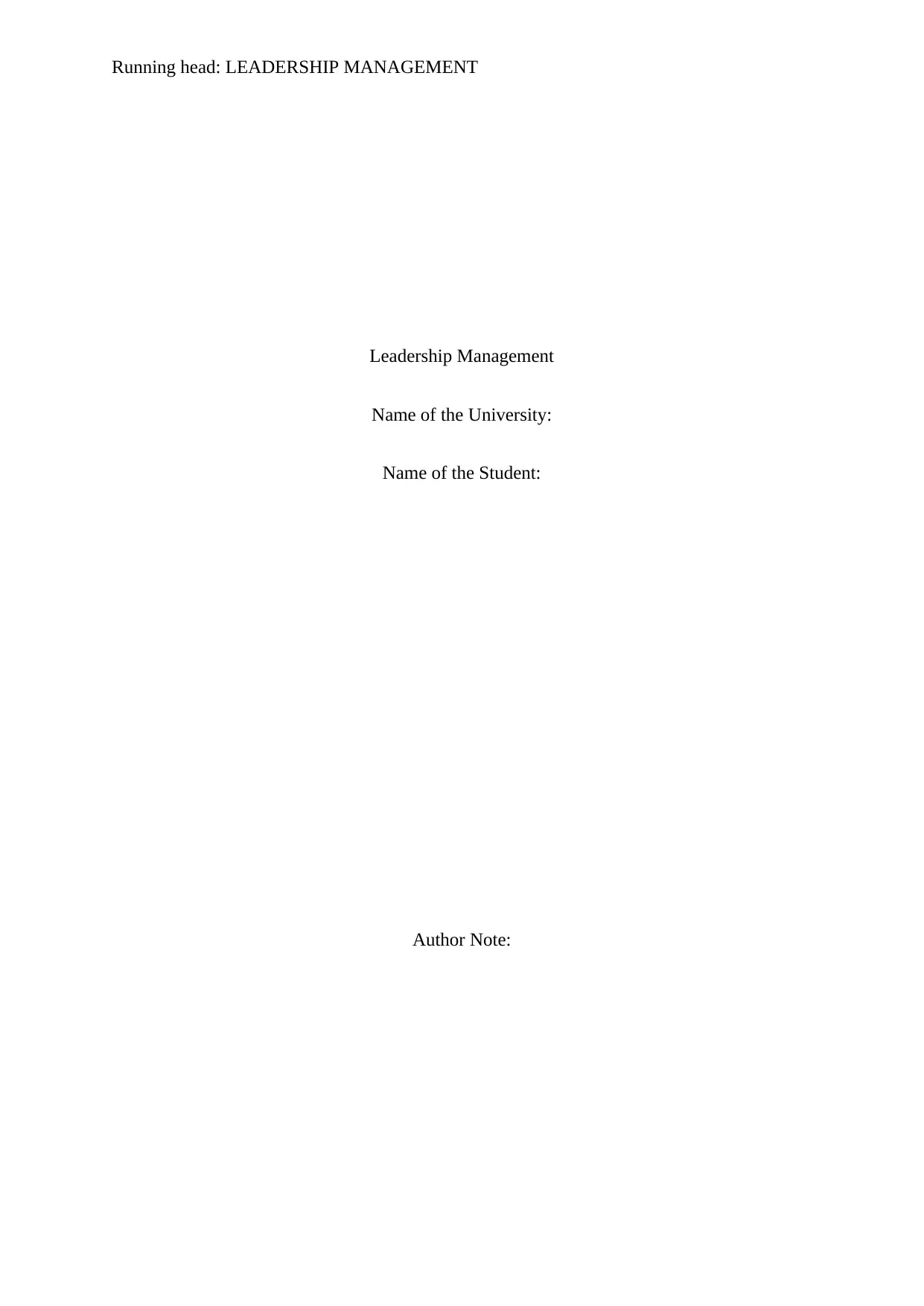
Running head: LEADERSHIP MANAGEMENT
Leadership Management
Name of the University:
Name of the Student:
Author Note:
Leadership Management
Name of the University:
Name of the Student:
Author Note:
Paraphrase This Document
Need a fresh take? Get an instant paraphrase of this document with our AI Paraphraser
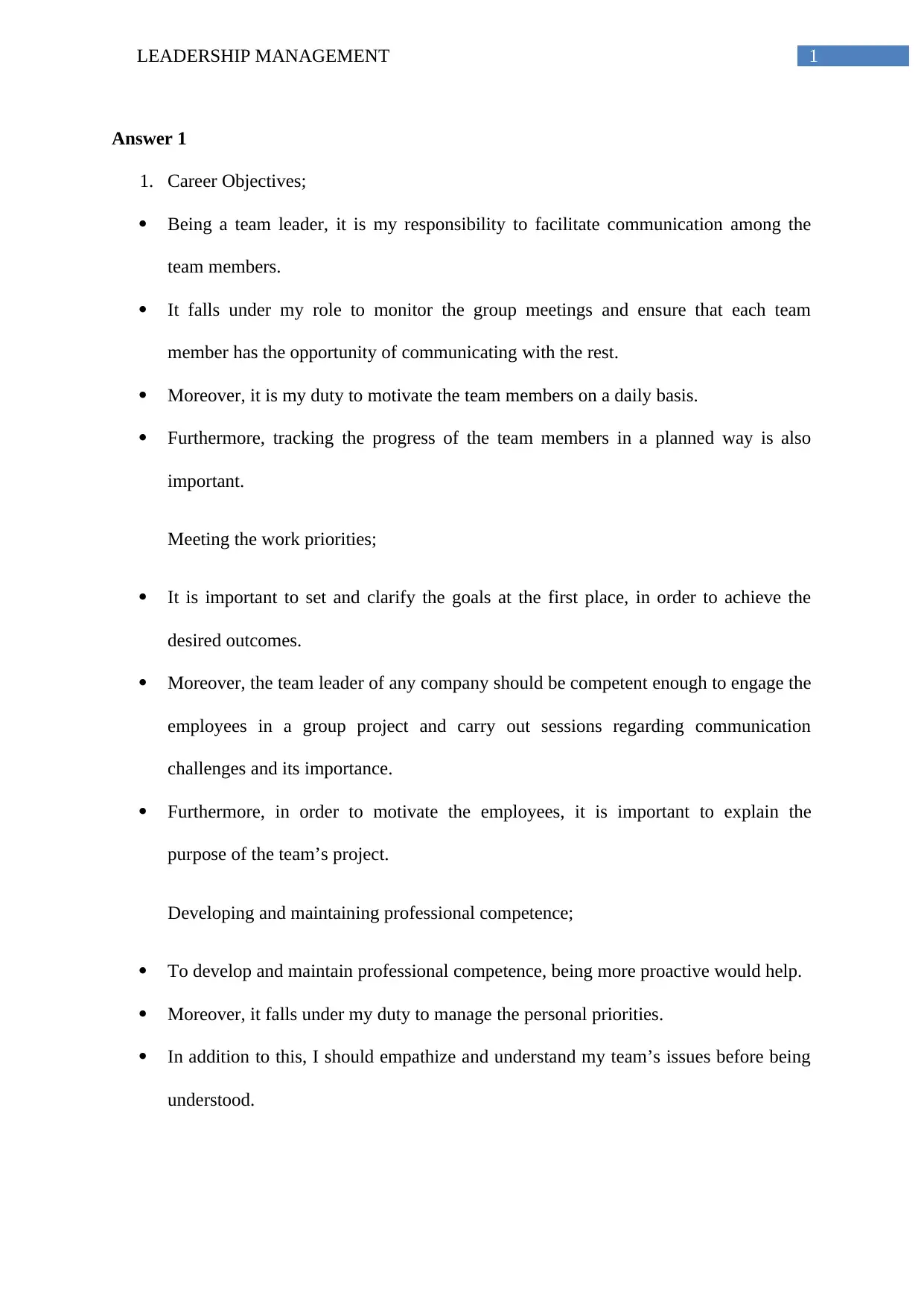
1LEADERSHIP MANAGEMENT
Answer 1
1. Career Objectives;
Being a team leader, it is my responsibility to facilitate communication among the
team members.
It falls under my role to monitor the group meetings and ensure that each team
member has the opportunity of communicating with the rest.
Moreover, it is my duty to motivate the team members on a daily basis.
Furthermore, tracking the progress of the team members in a planned way is also
important.
Meeting the work priorities;
It is important to set and clarify the goals at the first place, in order to achieve the
desired outcomes.
Moreover, the team leader of any company should be competent enough to engage the
employees in a group project and carry out sessions regarding communication
challenges and its importance.
Furthermore, in order to motivate the employees, it is important to explain the
purpose of the team’s project.
Developing and maintaining professional competence;
To develop and maintain professional competence, being more proactive would help.
Moreover, it falls under my duty to manage the personal priorities.
In addition to this, I should empathize and understand my team’s issues before being
understood.
Answer 1
1. Career Objectives;
Being a team leader, it is my responsibility to facilitate communication among the
team members.
It falls under my role to monitor the group meetings and ensure that each team
member has the opportunity of communicating with the rest.
Moreover, it is my duty to motivate the team members on a daily basis.
Furthermore, tracking the progress of the team members in a planned way is also
important.
Meeting the work priorities;
It is important to set and clarify the goals at the first place, in order to achieve the
desired outcomes.
Moreover, the team leader of any company should be competent enough to engage the
employees in a group project and carry out sessions regarding communication
challenges and its importance.
Furthermore, in order to motivate the employees, it is important to explain the
purpose of the team’s project.
Developing and maintaining professional competence;
To develop and maintain professional competence, being more proactive would help.
Moreover, it falls under my duty to manage the personal priorities.
In addition to this, I should empathize and understand my team’s issues before being
understood.

2LEADERSHIP MANAGEMENT
2. Company Name
Goal Planning Template
Employee Information
Employee
Name: Julia Geller
Employee
ID: AI905560
Job Title: Team Leader Department: Data Core
Manager: Annie Johnson
Date: September 3, 2018 Review Period: 2017 to 2018
1st Goal/Objective
Description:
Facilitating Communication
Measurement:
It falls under my responsibility to monitor the group meetings in order to ensure that each team
member is communicating with the rest. I should schedule meetings on a regular basis to improve
the quality of communication, increase efficiency and enhance effectiveness.
2. Company Name
Goal Planning Template
Employee Information
Employee
Name: Julia Geller
Employee
ID: AI905560
Job Title: Team Leader Department: Data Core
Manager: Annie Johnson
Date: September 3, 2018 Review Period: 2017 to 2018
1st Goal/Objective
Description:
Facilitating Communication
Measurement:
It falls under my responsibility to monitor the group meetings in order to ensure that each team
member is communicating with the rest. I should schedule meetings on a regular basis to improve
the quality of communication, increase efficiency and enhance effectiveness.
⊘ This is a preview!⊘
Do you want full access?
Subscribe today to unlock all pages.

Trusted by 1+ million students worldwide
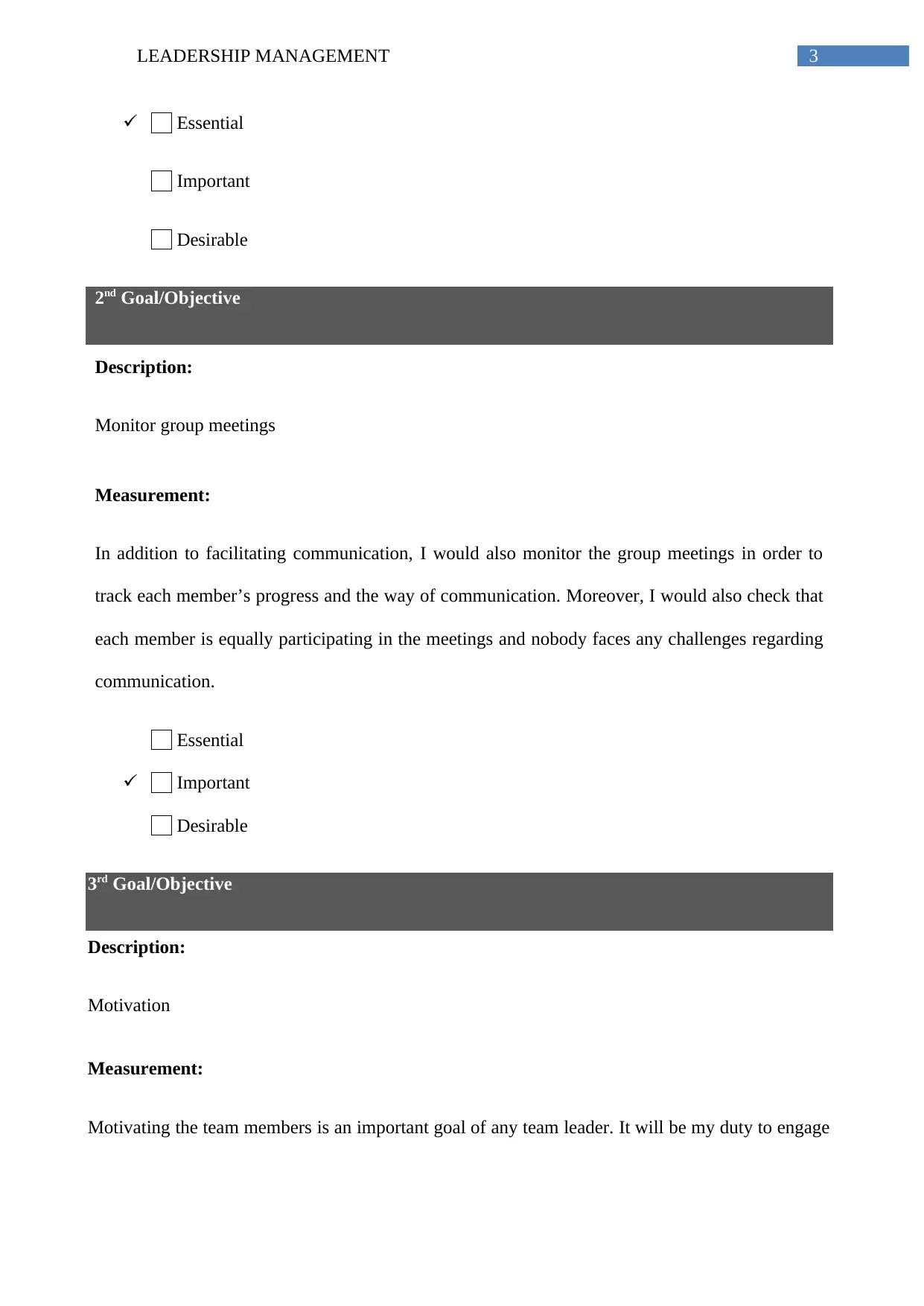
3LEADERSHIP MANAGEMENT
Essential
Important
Desirable
2nd Goal/Objective
Description:
Monitor group meetings
Measurement:
In addition to facilitating communication, I would also monitor the group meetings in order to
track each member’s progress and the way of communication. Moreover, I would also check that
each member is equally participating in the meetings and nobody faces any challenges regarding
communication.
Essential
Important
Desirable
3rd Goal/Objective
Description:
Motivation
Measurement:
Motivating the team members is an important goal of any team leader. It will be my duty to engage
Essential
Important
Desirable
2nd Goal/Objective
Description:
Monitor group meetings
Measurement:
In addition to facilitating communication, I would also monitor the group meetings in order to
track each member’s progress and the way of communication. Moreover, I would also check that
each member is equally participating in the meetings and nobody faces any challenges regarding
communication.
Essential
Important
Desirable
3rd Goal/Objective
Description:
Motivation
Measurement:
Motivating the team members is an important goal of any team leader. It will be my duty to engage
Paraphrase This Document
Need a fresh take? Get an instant paraphrase of this document with our AI Paraphraser

4LEADERSHIP MANAGEMENT
the team members into the goal setting processes.
Essential
Important
Desirable
4th Goal/Objective
Description:
Tracking the overall progress.
Measurement:
Being a team leader, it is also my responsibility to track the overall progress of every member.
Evaluating the team’s success in various stages is highly essential.
Essential
Important
Desirable
Answer 2
Personal Development Plan Template
Name: Julia Geller Date: September 3, 2018
the team members into the goal setting processes.
Essential
Important
Desirable
4th Goal/Objective
Description:
Tracking the overall progress.
Measurement:
Being a team leader, it is also my responsibility to track the overall progress of every member.
Evaluating the team’s success in various stages is highly essential.
Essential
Important
Desirable
Answer 2
Personal Development Plan Template
Name: Julia Geller Date: September 3, 2018

5LEADERSHIP MANAGEMENT
Objectives
What do I want to be
able to do
or do better?
Success criteria
How will I recognise
success?
How will I review
and measure my
improvement?
Actions
What methods will I use
to achieve my learning
objectives?
Implementation
How will I practise
and apply what I
learn?
Be proactive By managing
personal priorities.
By preparing a
checklist.
Developing a foresight,
planning for the future,
participate and perform.
By leading and
managing more and
more teams.
Empathise By understanding the
employees.
Understanding the
issues of the employees
and providing solution
to those.
Communicating
with the employees
on a personal level.
Focused By working
strategically.
Developing employees
and their capabilities for
future.
Managing the
current needs of the
team members.
Being more aware By being more
engaged into the
issues of the team.
Developing employee
engagement by
conducting sessions.
By monitoring the
progress of the
team.
Objectives
What do I want to be
able to do
or do better?
Success criteria
How will I recognise
success?
How will I review
and measure my
improvement?
Actions
What methods will I use
to achieve my learning
objectives?
Implementation
How will I practise
and apply what I
learn?
Be proactive By managing
personal priorities.
By preparing a
checklist.
Developing a foresight,
planning for the future,
participate and perform.
By leading and
managing more and
more teams.
Empathise By understanding the
employees.
Understanding the
issues of the employees
and providing solution
to those.
Communicating
with the employees
on a personal level.
Focused By working
strategically.
Developing employees
and their capabilities for
future.
Managing the
current needs of the
team members.
Being more aware By being more
engaged into the
issues of the team.
Developing employee
engagement by
conducting sessions.
By monitoring the
progress of the
team.
⊘ This is a preview!⊘
Do you want full access?
Subscribe today to unlock all pages.

Trusted by 1+ million students worldwide
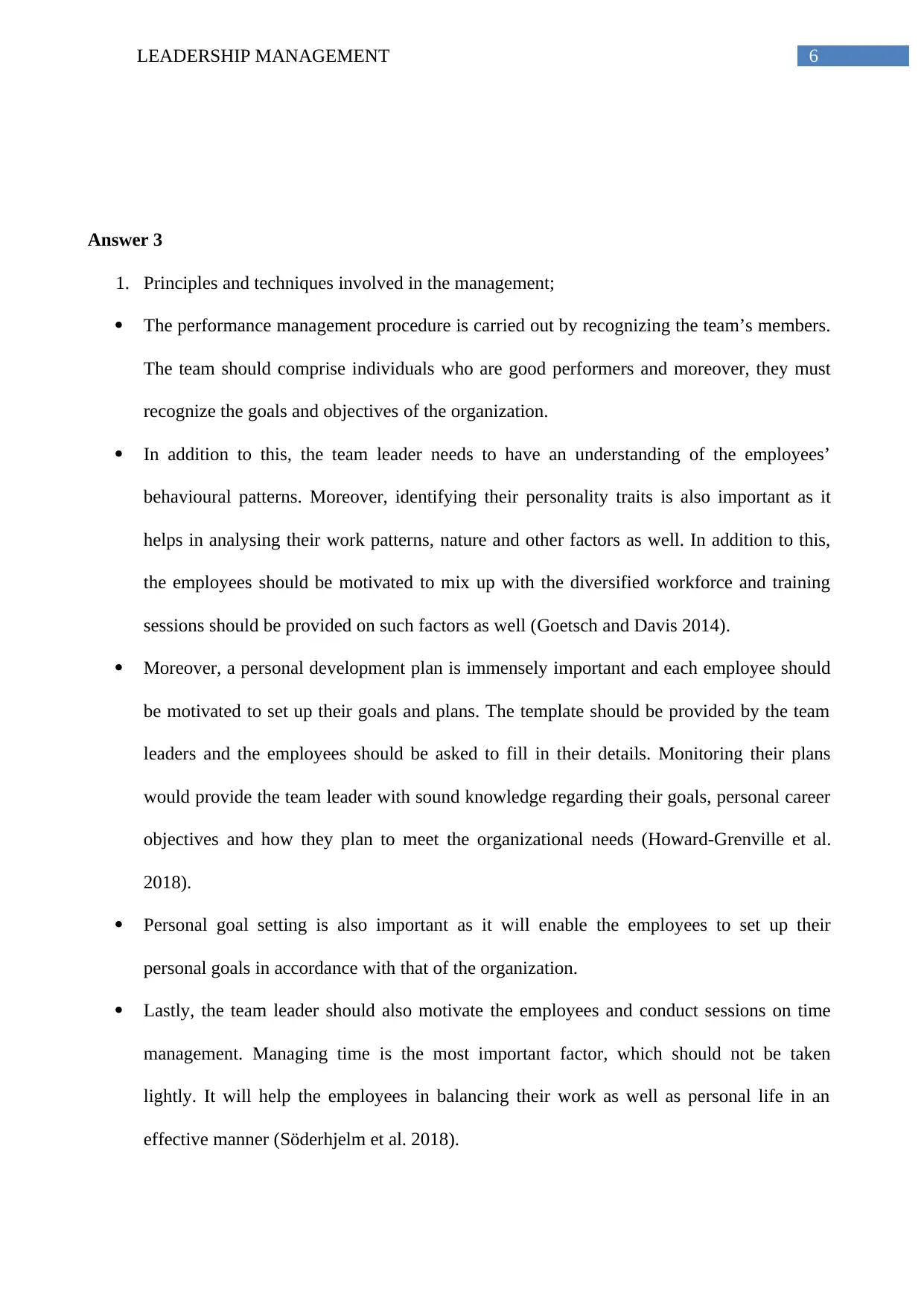
6LEADERSHIP MANAGEMENT
Answer 3
1. Principles and techniques involved in the management;
The performance management procedure is carried out by recognizing the team’s members.
The team should comprise individuals who are good performers and moreover, they must
recognize the goals and objectives of the organization.
In addition to this, the team leader needs to have an understanding of the employees’
behavioural patterns. Moreover, identifying their personality traits is also important as it
helps in analysing their work patterns, nature and other factors as well. In addition to this,
the employees should be motivated to mix up with the diversified workforce and training
sessions should be provided on such factors as well (Goetsch and Davis 2014).
Moreover, a personal development plan is immensely important and each employee should
be motivated to set up their goals and plans. The template should be provided by the team
leaders and the employees should be asked to fill in their details. Monitoring their plans
would provide the team leader with sound knowledge regarding their goals, personal career
objectives and how they plan to meet the organizational needs (Howard-Grenville et al.
2018).
Personal goal setting is also important as it will enable the employees to set up their
personal goals in accordance with that of the organization.
Lastly, the team leader should also motivate the employees and conduct sessions on time
management. Managing time is the most important factor, which should not be taken
lightly. It will help the employees in balancing their work as well as personal life in an
effective manner (Söderhjelm et al. 2018).
Answer 3
1. Principles and techniques involved in the management;
The performance management procedure is carried out by recognizing the team’s members.
The team should comprise individuals who are good performers and moreover, they must
recognize the goals and objectives of the organization.
In addition to this, the team leader needs to have an understanding of the employees’
behavioural patterns. Moreover, identifying their personality traits is also important as it
helps in analysing their work patterns, nature and other factors as well. In addition to this,
the employees should be motivated to mix up with the diversified workforce and training
sessions should be provided on such factors as well (Goetsch and Davis 2014).
Moreover, a personal development plan is immensely important and each employee should
be motivated to set up their goals and plans. The template should be provided by the team
leaders and the employees should be asked to fill in their details. Monitoring their plans
would provide the team leader with sound knowledge regarding their goals, personal career
objectives and how they plan to meet the organizational needs (Howard-Grenville et al.
2018).
Personal goal setting is also important as it will enable the employees to set up their
personal goals in accordance with that of the organization.
Lastly, the team leader should also motivate the employees and conduct sessions on time
management. Managing time is the most important factor, which should not be taken
lightly. It will help the employees in balancing their work as well as personal life in an
effective manner (Söderhjelm et al. 2018).
Paraphrase This Document
Need a fresh take? Get an instant paraphrase of this document with our AI Paraphraser

7LEADERSHIP MANAGEMENT
2. Organization’s procedures regarding professional development;
Position specific development policy ensures that the employees carry out their duties as
per their job positions, qualifications and descriptions within the working hours.
Non-position specific development policy permits any rearrangement of the working hours
for assisting employee personal development. It permits annual leaves and arranges for
unpaid leaves, depending on the emergency level.
Educational and training requirement policy involves reimbursement of the fees or
provision of study leaves, which is paid (Bolden 2016).
3. Types of learning style;
For training the employees in the most effective manner, the team leader needs to
understand their style of learning. This is immensely crucial in the fast paced environment
of the organizations.
The kinesthetic learner gains knowledge from direct practice and experience. They might
require adequate resources for effective training.
The auditory learner absorbs the information best when shared out loud. They get benefitted
from group discussions (Bush 2015).
Lastly, the visual learner learns when the information is presented in the form of an image.
They might find the auditory learning style ineffective as they easily lose interest during
lectures or group discussions.
2. Organization’s procedures regarding professional development;
Position specific development policy ensures that the employees carry out their duties as
per their job positions, qualifications and descriptions within the working hours.
Non-position specific development policy permits any rearrangement of the working hours
for assisting employee personal development. It permits annual leaves and arranges for
unpaid leaves, depending on the emergency level.
Educational and training requirement policy involves reimbursement of the fees or
provision of study leaves, which is paid (Bolden 2016).
3. Types of learning style;
For training the employees in the most effective manner, the team leader needs to
understand their style of learning. This is immensely crucial in the fast paced environment
of the organizations.
The kinesthetic learner gains knowledge from direct practice and experience. They might
require adequate resources for effective training.
The auditory learner absorbs the information best when shared out loud. They get benefitted
from group discussions (Bush 2015).
Lastly, the visual learner learns when the information is presented in the form of an image.
They might find the auditory learning style ineffective as they easily lose interest during
lectures or group discussions.

8LEADERSHIP MANAGEMENT
References
Bolden, R., 2016. Leadership, management and organisational development. In Gower handbook of
leadership and management development (pp. 143-158). Routledge.
Bush, T., 2015. Understanding instructional leadership.
Goetsch, D.L. and Davis, S.B., 2014. Quality management for organizational excellence. Upper
Saddle River, NJ: pearson.
Howard-Grenville, J., Davis, J., Dyllick, T., Joshi, A., Miller, C., Thau, S. and Tsui, A.S., 2017.
Sustainable Development for a Better World: Contributions of Leadership, Management and
Organizations: Submission deadline: July 1 to July 30, 2018. Academy of Management
Discoveries, 3(1), pp.107-110.
Söderhjelm, T., Björklund, C., Sandahl, C. and Bolander-Laksov, K., 2018. Academic leadership:
management of groups or leadership of teams? A multiple-case study on designing and
implementing a team-based development programme for academic leadership. Studies in Higher
Education, 43(2), pp.201-216.
References
Bolden, R., 2016. Leadership, management and organisational development. In Gower handbook of
leadership and management development (pp. 143-158). Routledge.
Bush, T., 2015. Understanding instructional leadership.
Goetsch, D.L. and Davis, S.B., 2014. Quality management for organizational excellence. Upper
Saddle River, NJ: pearson.
Howard-Grenville, J., Davis, J., Dyllick, T., Joshi, A., Miller, C., Thau, S. and Tsui, A.S., 2017.
Sustainable Development for a Better World: Contributions of Leadership, Management and
Organizations: Submission deadline: July 1 to July 30, 2018. Academy of Management
Discoveries, 3(1), pp.107-110.
Söderhjelm, T., Björklund, C., Sandahl, C. and Bolander-Laksov, K., 2018. Academic leadership:
management of groups or leadership of teams? A multiple-case study on designing and
implementing a team-based development programme for academic leadership. Studies in Higher
Education, 43(2), pp.201-216.
⊘ This is a preview!⊘
Do you want full access?
Subscribe today to unlock all pages.

Trusted by 1+ million students worldwide
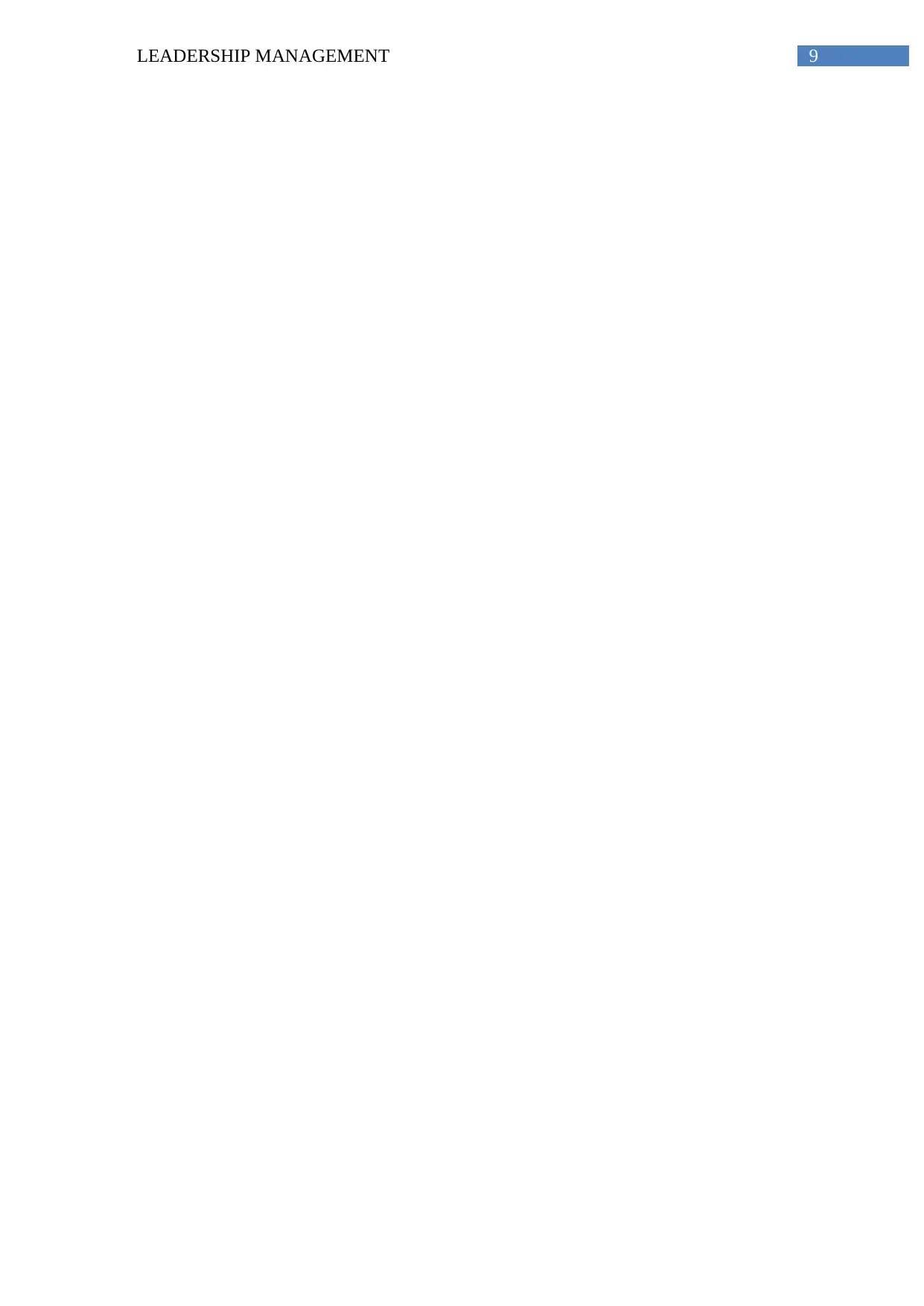
9LEADERSHIP MANAGEMENT
1 out of 10
Related Documents
Your All-in-One AI-Powered Toolkit for Academic Success.
+13062052269
info@desklib.com
Available 24*7 on WhatsApp / Email
![[object Object]](/_next/static/media/star-bottom.7253800d.svg)
Unlock your academic potential
Copyright © 2020–2025 A2Z Services. All Rights Reserved. Developed and managed by ZUCOL.





